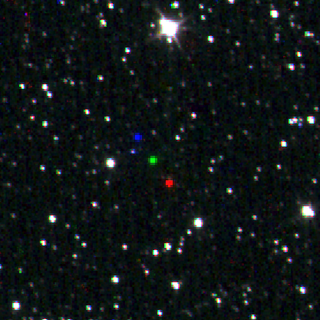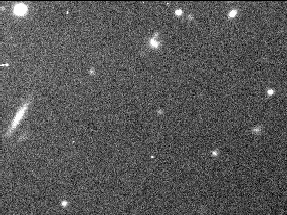Related Research Articles

Siarnaq, also designated Saturn XXIX, is the second-largest irregular moon of Saturn. It was discovered on 23 September 2000 by a team of astronomers led by Brett J. Gladman. It was named after the Inuit goddess of the sea, Siarnaq, who is more commonly known as Sedna. Siarnaq is the largest member of Saturn's Inuit group of prograde irregular moons, which orbit far from Saturn in the same direction as the planet's rotation. The moons of the Inuit group are believed to have originated as fragments from the collisional breakup of a larger progenitor moon after it was gravitationally captured into orbit around Saturn several billion years ago. Several other small Inuit group moons share similar orbits to Siarnaq, indicating that the moon had experienced another collision after forming from its progenitor.

Tarvos, or Saturn XXI, is a prograde irregular satellite of Saturn. It was discovered by John J. Kavelaars et al. on September 23, 2000, and given the temporary designation S/2000 S 4. The name, given in August 2003, is after Tarvos, a deity depicted as a bull god carrying three cranes alongside its back from Gaulish mythology.
S/2004 S 7 is a natural satellite of Saturn. Its discovery was announced by Scott S. Sheppard, David C. Jewitt, Jan Kleyna, and Brian G. Marsden on 4 May 2005 from observations taken between 12 December 2004 and 8 March 2005.
S/2004 S 12 is a natural satellite of Saturn. Its discovery was announced by Scott S. Sheppard, David C. Jewitt, Jan Kleyna, and Brian G. Marsden on 4 May 2005 from observations taken between 12 December 2004 and 9 March 2005.
S/2004 S 13 is a natural satellite of Saturn. Its discovery was announced by Scott S. Sheppard, David C. Jewitt, Jan Kleyna, and Brian G. Marsden on 4 May 2005 from observations taken between 12 December 2004 and 9 March 2005.

The Gallic group is a dynamical grouping of the prograde irregular satellites of Saturn following similar orbits. Their semi-major axes range between 16 and 19 Gm, their inclinations between 35° and 40°, and their eccentricities around 0.53. The International Astronomical Union (IAU) reserves names taken from Gallic mythology for these moons.

The Norse group is a large group of retrograde irregular satellites of Saturn. Their semi-major axes range between 12 and 24 Gm, their inclinations between 136° and 175° and their eccentricities between 0.13 and 0.77. Unlike for the Inuit and Gallic groups, the orbital parameters are widely dispersed and the group is likely to be composed from a number of subgroups with more homogenous orbital and physical parameters. The International Astronomical Union (IAU) reserves names taken from Norse mythology for these moons. The exception is Phoebe, the largest, which was discovered long before the others.
S/2006 S 3 is a natural satellite of Saturn. Its discovery was announced by Scott S. Sheppard, David C. Jewitt, Jan Kleyna, and Brian G. Marsden on June 26, 2006 from observations taken between January and April 2006.
Gridr, originally known as S/2004 S 20, is a natural satellite of Saturn. Its discovery was announced by Scott S. Sheppard, David C. Jewitt, and Jan Kleyna on October 7, 2019 from observations taken between December 12, 2004 and March 22, 2007. It was given its permanent designation in June 2021. On 24 August 2022, it was officially named after Gríðr, a jötunn in Norse mythology. She is the mother of Víðarr the silent and the consort of Odin. She warned Thor about the treachery of Geirröðr and equipped him with her belt of strength, her iron glove, and her staff Gríðarvöl (Gríðr's-staff).
Angrboda, provisionally known as S/2004 S 22, is a natural satellite of Saturn. Its discovery was announced by Scott S. Sheppard, David C. Jewitt, and Jan Kleyna on October 7, 2019 from observations taken between December 12, 2004 and February 1, 2006. It was given its permanent designation in August 2021. On 24 August 2022, it was officially named after Angrboða, a jötunn in Norse mythology. She is the consort of Loki and the mother of the wolf Fenrir, the Midgard serpent Jörmungandr, and the ruler of the dead Hel.
Skrymir, provisionally known as S/2004 S 23, is a natural satellite of Saturn. Its discovery was announced by Scott S. Sheppard, David C. Jewitt, and Jan Kleyna on October 7, 2019 from observations taken between December 12, 2004 and March 22, 2007. It was given its permanent designation in August 2021. On 24 August 2022, it was officially named after Útgarða-Loki. He is a jötunn from Norse mythology and master of illusions.
Gerd, provisionally known as S/2004 S 25, is a natural satellite of Saturn. Its discovery was announced by Scott S. Sheppard, David C. Jewitt, and Jan Kleyna on October 7, 2019 from observations taken between December 12, 2004 and March 22, 2007. It was given its permanent designation in August 2021. On 24 August 2022, it was officially named after Gerðr, a jötunn from Norse mythology. She is the wife of Freyr and the personification of fertile soil.
Saturn LVIII, provisionally known as S/2004 S 26, is a distant known natural satellite of Saturn. Its discovery was announced by Scott S. Sheppard, David C. Jewitt, and Jan Kleyna on October 7, 2019 from observations taken between December 12, 2004 and March 21, 2007. It was given its permanent designation in August 2021.
Eggther, provisionally known as S/2004 S 27, is a natural satellite of Saturn. Its discovery was announced by Scott S. Sheppard, David C. Jewitt, and Jan Kleyna on October 7, 2019 from observations taken between December 12, 2004 and March 21, 2007. It was given its permanent designation in August 2021. On 24 August 2022, it was officially named after Eggþér, a jötunn from Norse mythology. He is the herder of the female jötunn who lives in Járnviðr (Ironwood) and raises monstrous wolves. In the poem Völuspá, Eggþér is described as sitting on a mound and joyfully striking his harp while the red rooster Fjalarr begins to crow to herald the onset of Ragnarök.
Beli, provisionally known as S/2004 S 30, is a natural satellite of Saturn. Its discovery was announced by Scott S. Sheppard, David C. Jewitt, and Jan Kleyna on October 7, 2019, from observations taken between December 12, 2004, and March 21, 2007. It was given its permanent designation in August 2021. On 24 August 2022, it was named after Beli, a jötunn from Norse mythology. He is killed by Freyr with the antler of a hart (stag). According to John Lindow, the myth of Beli is partially lost. Some scholars suggest that he may be the brother of Freyr's wife Gerðr, although this is uncertain.
Gunnlod, provisionally known as S/2004 S 32, is a natural satellite of Saturn. Its discovery was announced by Scott S. Sheppard, David C. Jewitt, and Jan Kleyna on October 8, 2019 from observations taken between December 12, 2004 and January 19, 2007. It was given its permanent designation in August 2021. On 24 August 2022, it was officially named after Gunnlǫð, a jötunn from Norse mythology. She is the daughter of Suttungr and guarded the mead of poetry for him. But Odin in the form of a snake gained access to the chamber in Hnitbjorg where the mead was kept, seduced Gunnlǫð, and slept with her for three nights. In return Gunnlǫð allowed Odin three drinks of the mead, and he then immediately flew out of the cavern in the form of an eagle.
Thiazzi, provisionally known as S/2004 S 33, is a natural satellite of Saturn. Its discovery was announced by Scott S. Sheppard, David C. Jewitt, and Jan Kleyna on October 8, 2019 from observations taken between December 12, 2004 and March 22, 2007. It was given its permanent designation in August 2021. On 24 August 2022, it was officially named after Þjazi, a jötunn from Norse mythology. He is a son of Alvaldi and kidnapped the goddess Iðunn, who guarded the apples of the gods.
Saturn LXIV, provisionally known as S/2004 S 34, is a natural satellite of Saturn. Its discovery was announced by Scott S. Sheppard, David C. Jewitt, and Jan Kleyna on October 8, 2019, from observations taken between December 12, 2004, and March 21, 2007. It was given its permanent designation in August 2021.
Alvaldi, provisionally known as S/2004 S 35, is a natural satellite of Saturn. Its discovery was announced by Scott S. Sheppard, David C. Jewitt, and Jan Kleyna on October 8, 2019 from observations taken between December 12, 2004 and February 25, 2006. It was given its permanent designation in August 2021. On 24 August 2022, it was officially named after Alvaldi, a jötunn from Norse mythology. He was very rich in gold, and when he died his sons divided his inheritance by taking a mouthful each.
Geirrod, provisionally known as S/2004 S 38, is a natural satellite of Saturn. Its discovery was announced by Scott S. Sheppard, David C. Jewitt, and Jan Kleyna on October 8, 2019 from observations taken between December 12, 2004 and March 22, 2007. It was given its permanent designation in August 2021. On 24 August 2022, it was officially named after Geirröðr, a jötunn from Norse mythology. He is an enemy of Thor and is killed by him.
References
- ↑ Discovery Circumstances from JPL
- 1 2 S.S. Sheppard (2019), Moons of Saturn, Carnegie Science, on line
- 1 2 3 "Planetary Satellite Mean Elements". JPL Solar System Dynamics. NASA. Retrieved 6 May 2023.
- 1 2 Jacobson, Robert A.; Brozović, Marina; Mastrodemos, Nickolaos; Riedel, Joseph E.; Sheppard, Scott S. (December 2022). "Ephemerides of the Irregular Saturnian Satellites from Earth-based Astrometry and Cassini Imaging". The Astronomical Journal. 164 (6): 10. Bibcode:2022AJ....164..240J. doi: 10.3847/1538-3881/ac98c7 . 240.
- ↑ "MPEC 2019-T136 : S/2004 S 29". minorplanetcenter.net. Retrieved 7 October 2019.
- ↑ "M.P.C. 133821" (PDF). Minor Planet Center. International Astronomical Union. 10 August 2021. Retrieved 21 August 2021.
